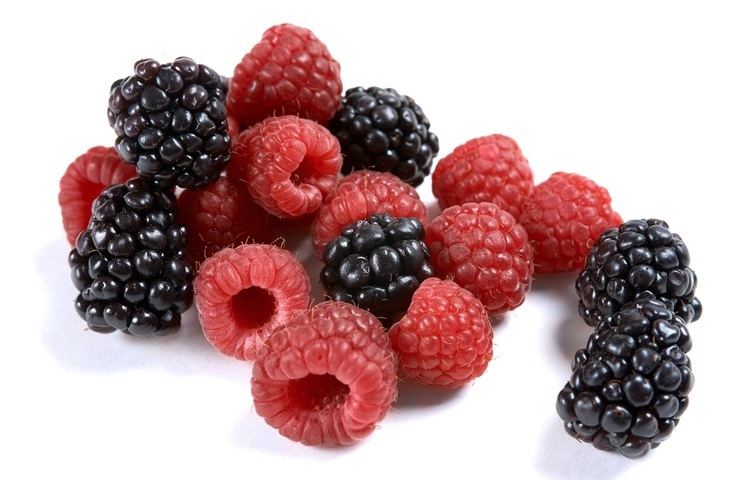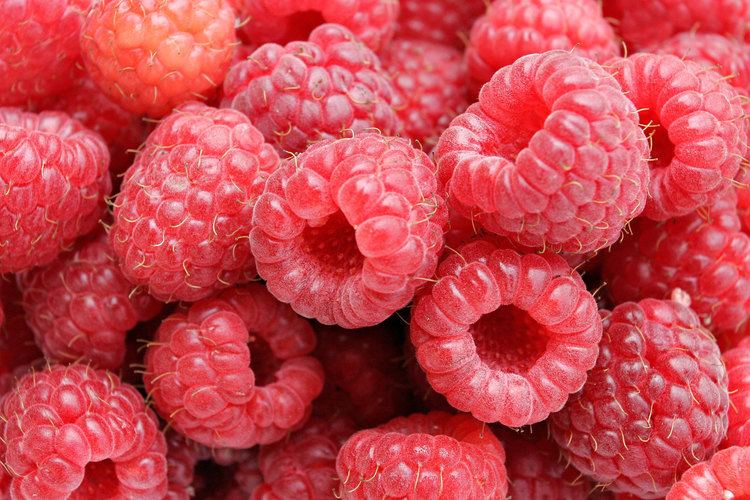Energy 220 kJ (53 kcal) Sugars 4.42 g Fat 0.65 g | Carbohydrates 11.94 g Dietary fiber 6.5 g Protein 1.2 g | |
 | ||
Similar Strawberry, Blueberry, Fruit, Blackberry, Berry | ||
raspberry is very beneficial for your health
The raspberry (/ˈræzˌbɛri/) is the edible fruit of a multitude of plant species in the genus Rubus of the rose family, most of which are in the subgenus Idaeobatus; the name also applies to these plants themselves.
Contents
- raspberry is very beneficial for your health
- Etymology
- Species
- Cultivation
- Major cultivars
- Selected cultivars
- Diseases and pests
- Production
- Fruit
- Nutrients
- Phytochemicals
- Leaves
- References
Raspberries are perennial with woody stems.
Etymology

Raspberry derives its name from raspise, "a sweet rose-colored wine" (mid-15th Century), from the Anglo-Latin, vinum raspeys, or from raspoie, meaning "thicket," of Germanic origin. The name may have been influenced by its appearance as having a rough surface related to Old English rasp or "rough berry".
Species
Examples of raspberry species in Rubus subgenus Idaeobatus include:

Several species of Rubus, also called raspberries, are classified in other subgenera, including:

Cultivation
Various kinds of raspberries can be cultivated from hardiness zones 3 to 9. Raspberries are traditionally planted in the winter as dormant canes, although planting of tender, plug plants produced by tissue culture has become much more common. A specialized production system called "long cane production" involves growing canes for a year in a northern climate such as Scotland or Oregon or Washington, where the chilling requirement for proper bud break is attained, or attained earlier than the ultimate place of planting. These canes are then dug, roots and all, to be replanted in warmer climates such as Spain, where they quickly flower and produce a very early season crop. Plants are typically planted 2-6 per m in fertile, well drained soil; raspberries are usually planted in raised beds/ridges, if there is any question about root rot problems.
The flowers can be a major nectar source for honeybees and other pollinators.
Raspberries are very vigorous and can be locally invasive. They propagate using basal shoots (also known as suckers), extended underground shoots that develop roots and individual plants. They can sucker new canes some distance from the main plant. For this reason, raspberries spread well, and can take over gardens if left unchecked. Raspberries are often propagated using cuttings, and will root readily in moist soil conditions.

The fruit is harvested when it comes off the receptacle easily and has turned a deep color (red, black, purple, or golden yellow, depending on the species and cultivar). This is when the fruits are ripest and sweetest. Excess fruit can be made into raspberry jam or frozen.
High tunnel bramble production offers the opportunity to bridge gaps in availability during late fall and late spring. Furthermore, high tunnels allow less hardy floricane-fruiting raspberries to overwinter in climates where they wouldn't otherwise survive. In the tunnel plants are established at close spacing usually prior to tunnel construction.
Major cultivars
Raspberries are an important commercial fruit crop, widely grown in all temperate regions of the world.
Many of the most important modern commercial red raspberry cultivars derive from hybrids between R. idaeus and R. strigosus. Some botanists consider the Eurasian and American red raspberries to belong to a single, circumboreal species, Rubus idaeus, with the European plants then classified as either R. idaeus subsp. idaeus or R. idaeus var. idaeus, and the native North American red raspberries classified as either R. idaeus subsp. strigosus, or R. idaeus var. strigosus. Recent breeding has resulted in cultivars that are thornless and more strongly upright, not needing staking.
The black raspberry, Rubus occidentalis, is also cultivated, providing both fresh and frozen fruit, as well as jams, preserves, and other products, all with that species' distinctive flavor.
Purple raspberries have been produced by horticultural hybridization of red and black raspberries, and have also been found in the wild in a few places (for example, in Vermont) where the American red and the black raspberries both grow naturally. Commercial production of purple-fruited raspberries is rare.
Blue raspberry is a local name used in Prince Edward County, Ontario, Canada for the cultivar 'Columbian', a hybrid (purple raspberry) of R. strigosus and R. occidentalis.
Both the red and the black raspberry species have albino-like pale-yellow natural or horticultural variants, resulting from presence of recessive genes that impede production of anthocyanin pigments. Fruits from such plants are called golden raspberries or yellow raspberries; despite their similar appearance, they retain the distinctive flavor of their respective species (red or black). Most pale-fruited raspberries commercially sold in the eastern United States are derivatives of red raspberries. Yellow-fruited variants of the black raspberry are sometimes grown in home gardens.
Red raspberries have also been crossed with various species in other subgenera of the genus Rubus, resulting in a number of hybrids, the first of which was the loganberry. Later notable hybrids include boysenberry (a multi-generation hybrid), and tayberry. Hybridization between the familiar cultivated red raspberries and a few Asiatic species of Rubus has also been achieved.
Selected cultivars
Numerous raspberry cultivars have been selected.
Two types of raspberry are available for commercial and domestic cultivation; the summer-bearing type produces an abundance of fruit on second-year canes (floricanes) within a relatively short period in midsummer, and double or "everbearing" plants, which also bear some fruit on first-year canes (primocanes) in the late summer and fall, as well as the summer crop on second-year canes. Those marked (AGM) have gained the Royal Horticultural Society's Award of Garden Merit.
Diseases and pests
Raspberries are sometimes eaten by the larvae of some Lepidoptera species (butterflies and moths). Botrytis cinerea, or gray mold, is a common fungal infection of raspberries and other soft fruit under wet conditions. It is seen as a gray mold growing on the raspberries, and particularly affects fruit which are bruised, as it provides an easy entrance point for the spores.
Raspberry plants should not be planted where potatoes, tomatoes, peppers, eggplants, or bulbs have previously been grown, without prior fumigation of the soil. These crops are hosts for the disease Verticillium wilt, a fungus that can stay in the soil for many years and can infest the raspberry crop.
Production
In 2013, total world production of raspberries was 578,233 tonnes, with Russia supplying 25% (143,000 tonnes) (table). Other major producers were Poland (21%) and the United States (16%) (table).
Fruit
Raspberries are grown for the fresh fruit market and for commercial processing into individually quick frozen (IQF) fruit, purée, juice, or as dried fruit used in a variety of grocery products. Traditionally, raspberries were a midsummer crop, but with new technology, cultivars, and transportation, they can now be obtained year-round. Raspberries need ample sun and water for optimal development. Raspberries thrive in well-drained soil with a pH between 6 and 7 with ample organic matter to assist in retaining water. While moisture is essential, wet and heavy soils or excess irrigation can bring on Phytophthora root rot, which is one of the most serious pest problems facing the red raspberry. As a cultivated plant in moist, temperate regions, it is easy to grow and has a tendency to spread unless pruned. Escaped raspberries frequently appear as garden weeds, spread by seeds found in bird droppings.
An individual raspberry weighs 3–5 g (0.11–0.18 oz), and is made up of around 100 drupelets, each of which consists of a juicy pulp and a single central seed. A raspberry bush can yield several hundred berries a year. Unlike blackberries and dewberries, a raspberry has a hollow core once it is removed from the receptacle.
Nutrients
Raw raspberries are 86% water, 12% carbohydrates, and have about 1% each of protein and fat (table). In a 100 gram amount, raspberries supply 53 calories.
The aggregate fruit structure contributes to raspberry's nutritional value, as it increases the proportion of dietary fiber, which is among the highest known in whole foods, up to 6% fiber per total weight. Raspberries are a rich source (20% or more of the Daily Value, DV) of vitamin C (32% DV), manganese (32% DV) and dietary fiber (26% DV) (table). Raspberries are a low-glycemic index food, with total sugar content of only 4% and no starch.
Phytochemicals
Raspberries contain phytochemicals, such as anthocyanin pigments, ellagic acid, ellagitannins, quercetin, gallic acid, cyanidins, pelargonidins, catechins, kaempferol and salicylic acid. Yellow raspberries and others with pale-colored fruits are lower in anthocyanin content. Both yellow and red raspberries contain carotenoids, mostly lutein esters, but these are masked by anthocyanins in red raspberries.
Raspberry compounds are under preliminary research for their potential to affect human health.
Leaves
Raspberry leaves can be used fresh or dried in herbal teas, providing an astringent flavor. In herbal and traditional medicine, raspberry leaves are used for some remedies, although there is no scientifically valid evidence to support their medicinal use.
